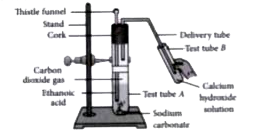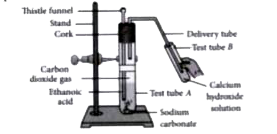Complete Solutions to SECTION - B of chapter FOOTSTEPS TOWARDS CBSE BOARD of Class 10 book with complete answers and questions
| Class 10 | CHEMISTRY |
| Chapter | FOOTSTEPS TOWARDS CBSE BOARD |
| MTG IIT JEE FOUNDATION | SECTION - B |
| Number Of Questions | 34 |
| Academic Year | 2023-24 |
A carboxylic acide `C_(2)H_(4)O_(2)` reacts with an alcohol in the presence of `H_(2)SO_(4)` to form a compound 'X'. The alcohol on oxidation with alkaline `KMnO_4` following by acidification gives the same caboxylic acid, `C_(2)H_(4)O_(2)`. Write the name and structure of
Carboxylic acid.02:08View SolutionA carboxylic acide `C_(2)H_(4)O_(2)` reacts with an alcohol in the presence of `H_(2)SO_(4)` to form a compound 'X'. The alcohol on oxidation with alkaline `KMnO_4` following by acidification gives the same caboxylic acid, `C_(2)H_(4)O_(2)`. Write the name and structure of
Alcohol.01:44View SolutionA carboxylic acide `C_(2)H_(4)O_(2)` reacts with an alcohol in the presence of `H_(2)SO_(4)` to form a compound 'X'. The alcohol on oxidation with alkaline `KMnO_4` following by acidification gives the same caboxylic acid, `C_(2)H_(4)O_(2)`. Write the name and structure of
The compound 'X'.01:56View SolutionThe following chemicals are available in a laboratory: Copper sulphate, Ferrous sulphate, Barium chloride, Sodium sulphate, Quick lime.
Select the appropriate chemicals to study the following reactions :
Combination01:19View SolutionThe following chemicals are available in a laboratory: Copper sulphate, Ferrous sulphate, Barium chloride, Sodium sulphate, Quick lime.
Select the appropriate chemicals to study the following reactions :
Decomposition.01:23View SolutionWhat is a reduction reaction?
Identify the substances that are oxidised and the substances that are reduced in the following reactions :
`Fe_(2)O_(3)+2Al to Al_(2)O_(3)+2Fe`View SolutionWhat is a reduction reaction?
Identify the substances that are oxidised and the substances that are reduced in the following reactions :
`2PbO+C to 2Pb+CO_(2)`View SolutionStudy the following chemical reaction and identify the type of reaction.
`H_(2)+Cl_(2) to 2HCl`01:03View SolutionTwo elements M and N belonge to group I and II respectively and are in the same period of the periodic table. How do the following properties of M and N vary ?
Sizes the their atoms01:25View SolutionTwo elements M and N belonge to group I and II respectively and are in the same period of the periodic table. How do the following properties of M and N vary ?
Their metalic characters01:36View SolutionTwo elements M and N belonge to group I and II respectively and are in the same period of the periodic table. How do the following properties of M and N vary ?
Their valencies in forming oxides01:49View SolutionCompound 'A' when dissolved in water gives compound 'B' which is used in white washing. Compound 'B' reacts with `CO_2` to form a white preciptate of compound 'C'. Identify compounds 'A', 'B' and ,C'. Also write the equations involved.
View SolutionWhat is indicated by:
Sooty flame01:17View SolutionWhat is indicated by:
Blue flame of a bunsen burner?01:10View SolutionRiya performs two set of experiments to study the length of the foam formed which are as follows:
Set I: she takes 10 ml of distilled water in test tube and adds 5-6 drops of liquid soap init and shakes the test tube vigorously.
Set II : she takes 10 ml of distilled water in a test tube and adds 5-6 drops of liquid soap with half spoonful of `CaSO_4` in it and shakes the test tube.
Write your observation and reason.02:12View SolutionLook at the figure shown and answer the following questions :

What change would you observe in the calcium hydroxide solution taken in test tube B?01:10View SolutionLook at the figure shown and answer the following questions :

Write the reactions involved in test tubes A and B respectively.01:51View SolutionLook at the figure shown and answer the following questions :

If ethanol is given instead of ethanoic acid, would you expect the same change?01:19View SolutionA zinc plate was kept in a glass container having `CuSo_4` solution. On examining it was found that the blue colour of the solution is getting fader and fader. After a few days when the zinc plate was taken out of the solution, a number of small holes were noticed in it. State the reason and give the chemical reactions involved.
View SolutionName two metals with very low melting point.
View SolutionName two metal oxides which are soluble in water.
01:11View SolutionMetal compound (A) reacts with dilute hydrochloric acid to produce effervescence. The gas evolved extinguishes a burning candle. Write a balanced chemical equation for the reaction if one of the compound formed is calcium chloride.
View SolutionWrite the balanced equation in molecular form illustrating the complete neutralization of `Al(OH)_(3)` with `H_(2)SO_(4)`.
View SolutionGive reasons for the following:
Reaction of calcium with water is less violent.01:10View SolutionGive reasons for the following:
Prior to reduction,the metal sulphides and carbonates must be converted into metal oxides for extracting metals.View SolutionClassify the type of reaction used to determine relative reactivities of metals.
View SolutionName three metals which occur in free state.
View SolutionName two chlorides and two sulphates which are responsible for not giving foam with soap.How do you compare the cleansing capacity of different samples of water?
View Solution(i) Electropositive nature of the element(s) increases down the group and decrease across the period.
(ii) Electronegativity of the element decreases down the group and increases across the period.
(iii) Atomic size increases down the group and decrease across the period.
(iv) Metallic character increases down the group and decreases across the period.
On the basis of the above trends of the periodic table, answer the following about the elements with atomic number 3 to 9.
Name the most electronegative among them.View Solution(i) Electropositive nature of the element(s) increases down the group and decrease across the period.
(ii) Electronegativity of the element decreases down the group and increases across the period.
(iii) Atomic size increases down the group and decrease across the period.
(iv) Metallic character increases down the group and decreases across the period.
On the basis of the above trends of the periodic table, answer the following about the elements with atomic number 3 to 9.
Name the element with smallest atomic size.View Solution(i) Electropositive nature of the element(s) increases down the group and decrease across the period.
(ii) Electronegativity of the element decreases down the group and increases across the period.
(iii) Atomic size increases down the group and decrease across the period.
(iv) Metallic character increases down the group and decreases across the period.
On the basis of the above trends of the periodic table, answer the following about the elements with atomic number 3 to 9.
Name the element which is a metalloid.View SolutionGiven below are some elements fo the modern periodic table. Atomic number of the element is given in the parentheses :
A(4), B(9), C(14), D(19), E(20).
Select the element that has one electron in the outermost shell. Also write the electronic configuration of that element.View SolutionGiven below are some elements fo the modern periodic table. Atomic number of the element is given in the parentheses :
A(4), B(9), C(14), D(19), E(20).
Which two elements amongst these belong to the same group? Give reason for your answer.View SolutionGiven below are some elements fo the modern periodic table. Atomic number of the element is given in the parentheses :
A(4), B(9), C(14), D(19), E(20).
Which two elements amongst these belong to the same period?View Solution
SECTION - B questions and complete solutions for chapter FOOTSTEPS TOWARDS CBSE BOARD of MTG IIT JEE FOUNDATION of Class 10
